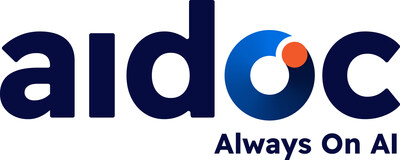Aidoc’s New AI Patient Management Technology Boosts Clinic Volumes and Elevates Patient Care

Yale New Haven Health unveils impact data during the 2024 Vascular Annual Meeting (VAM), showing Aidoc AI’s ability to support the identification of commonly missed follow-up cases
NEW YORK, June 20, 2024 /PRNewswire/ — Coronary artery calcifications (CAC), aortic aneurysms (AA), brain aneurysms, and many other important findings are often missed or not routed for appropriate care due to various factors, including heavy caseloads and fragmented workflows. Studies have found that up to 56% of incidental CAC and 35% of incidental AAs go undetected or unreported1 2.
Committed to leveraging AI for enhanced patient care, Aidoc has unveiled its latest advancements in AI-powered patient management. This innovative technology ensures that patients requiring follow-up for incidental or chronic conditions are accurately identified, captured and monitored, bridging critical gaps in healthcare delivery.
Aidoc’s groundbreaking aiOS™ platform harnesses imaging-based and text-based solutions to significantly enhance the identification and awareness of various medical conditions and connect patients to specialty clinics. This new patient management solution integrates seamlessly with electronic health records (EHR) and utilizes text-based AI to create a comprehensive view of each patient’s health while pinpointing those who require follow-up care.
“Aidoc’s AI technology is a transformative force in patient management,” said Elad Walach, CEO, Aidoc. “Our platform, with its diverse integrated solutions, doesn’t just enhance diagnostic precision—it revolutionizes the entire follow-up process, ensuring no patient falls through the cracks. By integrating comprehensive data analysis with clinical insights, we empower healthcare providers to deliver timely and effective care, ultimately setting a new benchmark for patient outcomes and operational efficiency.”
Yale New Haven Hospital deployed Aidoc’s AA patient management solution to enhance its aortic aneurysm management program. The results, presented at the Vascular Annual Meeting (VAM), were significant: clinic volume for follow-up nearly doubled, the time to intervention decreased from 270 days to 58 days, the number of interventions grew by 14%, and the aneurysm rupture rate reduced by 62% from 1.3% to 0.5%.
“Aidoc’s comprehensive patient management platform has transformed our approach to patients with abdominal aortic aneurysms (AAA),” said Edouard Aboian, MD, assistant professor of vascular surgery, Yale School of Medicine. “The integration of AI technology into our workflow has increased the number of AAA patients, improved long-term follow-up and greatly reduced the time to appointment and intervention. This technology has truly bridged the gap between radiologic findings and patient care, allowing us to provide timely and effective treatments.”
Aidoc’s technology supports clinicians by identifying both anticipated and incidental suspected findings, contributing to workflow efficiencies and enabling clinicians with the information they need to deliver the right care at the right time. The addition of the patient management solution not only bridges the gap between radiologic findings and patient follow-up but also directs patients to the appropriate specialty clinics, optimizing care pathways and elevating the standard of healthcare delivery.
Patients are automatically categorized and sorted by specific findings into relevant clinics, streamlining the workflow for specialists. For instance, AA patients are directed to vascular clinics, while brain aneurysm patients are directed to neurointerventional clinics. This systematic approach ensures that specialists’ clinics are automatically populated with patients who need their expertise, enhancing the efficiency of healthcare delivery
Aidoc’s innovative approach to patient management represents a paradigm shift in healthcare technology. By ensuring no detail is overlooked and every patient receives the follow-up they need, Aidoc is setting a new standard in patient care and operational efficiency. This technology promises to reshape the landscape of medical diagnostics and patient management, making healthcare more proactive, precise and patient-centric than ever before.
1. Williams, K. A., Kim, J. T., & Holohan, K. M. (2013). Frequency of unrecognized, unreported, or underreported coronary artery and cardiovascular calcification on noncardiac chest CT. Journal of Cardiovascular Computed Tomography, 7(3), 167–172. https://doi.org/10.1016/j.jcct.2013.05.003
2. Claridge, R., Arnold, S., Morrison, N., & Van Rij, A. M. (2017). Measuring abdominal aortic diameters in routine abdominal computed tomography scans and implications for abdominal aortic aneurysm screening. Journal of Vascular Surgery, 65(6), 1637–1642. https://doi.org/10.1016/j.jvs.2016.11.044
About Aidoc
Aidoc is a pioneering force in clinical AI. We focus on aiding and empowering healthcare teams to optimize patient treatment, which results in improved economic value and clinical outcomes. Our clinically proven AI solutions eliminate silos, increase efficiencies, and improve outcomes by delivering critical information when and where care teams need it leading to immediate collective action. Built on Aidoc’s proprietary aiOS™, we analyze and aggregate medical data to enable care teams to operationalize the unexpected and work seamlessly with a continued focus on the patient. Used in more than 1,000 medical centers worldwide, Aidoc has the most FDA clearances (17) in clinical AI and its AI-based solutions cover 75 percent of patient populations, enabling physicians to make informed decisions based on real-time data. Aidoc AI is always on, running in the background to change the foreground. Visit Aidoc.com to see how we are connecting all points of care with always on AI.
Logo – https://mma.prnewswire.com/media/2015772/4772347/Aidoc_Always_On_AI_Logo.jpg
![]() View original content to download multimedia:https://www.prnewswire.com/news-releases/aidocs-new-ai-patient-management-technology-boosts-clinic-volumes-and-elevates-patient-care-302177554.html
View original content to download multimedia:https://www.prnewswire.com/news-releases/aidocs-new-ai-patient-management-technology-boosts-clinic-volumes-and-elevates-patient-care-302177554.html
SOURCE Aidoc


